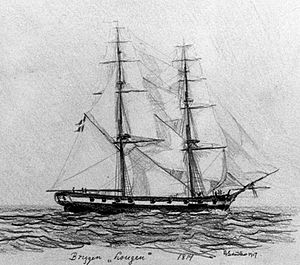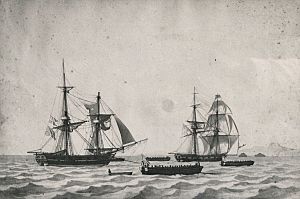HDMS Lougen (1805) facts for kids

An 1814 drawing of Lougen
|
|
Quick facts for kids History |
|
|---|---|
| Name | Lougen |
| Builder | Stibolt of Nyholm, Copenhagen |
| Launched | 20 July 1805 |
| Fate | Transferred to Norway in 1814 |
| Name | Lougen |
| Acquired | 1814 |
| Decommissioned | Sold to merchant service 1825 |
| Fate | Wrecked in 1881 at Bremerhaven |
| General characteristics | |
| Class and type | Brig-of-war |
| Displacement | 310 tons |
| Length |
|
| Beam | 27 ft 4 in (8.33 m) |
| Depth of hold | 10 ft 3 in (3.12 m) |
| Sail plan | Brig |
| Complement | 85 men |
| Armament | 18 × short 18-pounder guns + 2 × long 6-pounder guns in 1808 |
The HDMS Lougen was a Danish warship built in 1805. It was a type of sailing ship called a brig, which has two masts. The Lougen served in the Danish navy. It fought in two important battles against the British Royal Navy during the Gunboat War. In 1814, the ship was given to the Norwegian navy because of a peace agreement called the Treaty of Kiel. The Norwegians later sold it in 1825. The Lougen was finally shipwrecked near Bremerhaven in 1881.
Contents
Lougen: A Danish Warship
Battle with HMS Childers
On March 14, 1808, the Lougen found a British ship named Childers. The Childers was protecting other ships in Norwegian waters. The Lougen tried for many hours to start a fight. It finally succeeded in battling the British ship. The Childers was badly damaged but managed to get away. Its crew also had some injuries.
Battle with HMS Seagull

On June 19, 1808, the Lougen was near Kristiansand, Norway. It met and was chased by a British ship called Seagull. The Lougen, led by First Lieutenant Peter Frederik Wulff, tried to stay far from the Seagull. This was to use its powerful 18-pounder guns from a distance. The Seagull had shorter-range 24-pounder guns.
The chase brought both ships close to the shore. The strong wind started to die down. The Seagull tried to get between the Lougen and the shore. This would stop the Lougen from reaching Kristiansand.
About 20 minutes into the fight, six Danish gunboats arrived. They came from behind some rocks. They split into two groups of three. These gunboats took positions behind the Seagull. They fired their 24-pounder guns. At the same time, the Lougen fired at the Seagull's left side.
Within half an hour, the Danish attack caused a lot of damage. The Seagulls ropes and sails were badly hit. Five of its guns were knocked out of place. Finally, the Seagulls captain, Commander Robert B. Cathcart, gave up. He was badly hurt. Eight of his men were killed and 20 were wounded. The Lougen had only one man killed and 12 men slightly wounded.
Soon after the Seagull surrendered, its crew and wounded were taken off. Then, the Seagull sank. Some of the Danish crew from the Lougen drowned as the Seagull went down. The Danes later pulled the Seagull out of the water. They then added it to their own navy.
Adventures in Northern Waters
Jochum Nicolay Müller took command of the Lougen in 1809. He was from Trondheim, Norway. In the summer of 1809, three British ships were in northern Norway. They were HMS Snake, HMS Nightingale, and HMS Gallant. They briefly took over Hammerfest, a small town near North Cape.
In the spring of 1810, the Lougen and another Danish-Norwegian ship, Langeland, sailed north. They reached Hammerfest on June 28. Three Norwegian gun-schooners joined them. These were Nornen, Valkyren, and Axel Thorsen. Each had two powerful 24-pounder guns. This group of ships went to find the British ships. However, the maps for these northern waters were not very good.
The two remaining British ships, Nightingale and Gallant, had been warned. They left before the Danish ships arrived. They sailed to Greenland to protect British whaling ships. With no enemy around, trade with Russia grew. The Danish ships then protected a group of merchant ships. They escorted 11 captured merchant ships into Trondheim.
On July 31, 1811, the Lougen was sailing with two other ships, Lolland and Kiel. They met two British ships, HMS Brev Drageren and HMS Algerine, in Long Sound, Norway. The Danish ships had 54 guns and 480 men. The British ships had 22 guns and 107 men. The British ships were greatly outnumbered and outgunned. They quickly sailed away.
The next day, the Brev Drageren tried to fight the Danish ships again. First it fought one, then two of the Danish ships. The fight was not decisive. Each British ship had one man killed. The Brev Drageren also had three men wounded. In this second day's fight, the Algerine sent a boat to help the Brev Drageren. This helped the Brev Drageren escape the Danes. Its crew had to row for 30 hours to get away. The Lolland captured two merchant ships that the Brev Drageren had been protecting.
The End of Lougen
After the Treaty of Kiel was signed, Norway separated from Denmark. In 1814, the Lougen was given to the Norwegian navy. In 1825, the Norwegians sold the ship. It became a merchant ship and moved to the Scheldt area. The Lougen was shipwrecked in 1881 near Bremerhaven.

